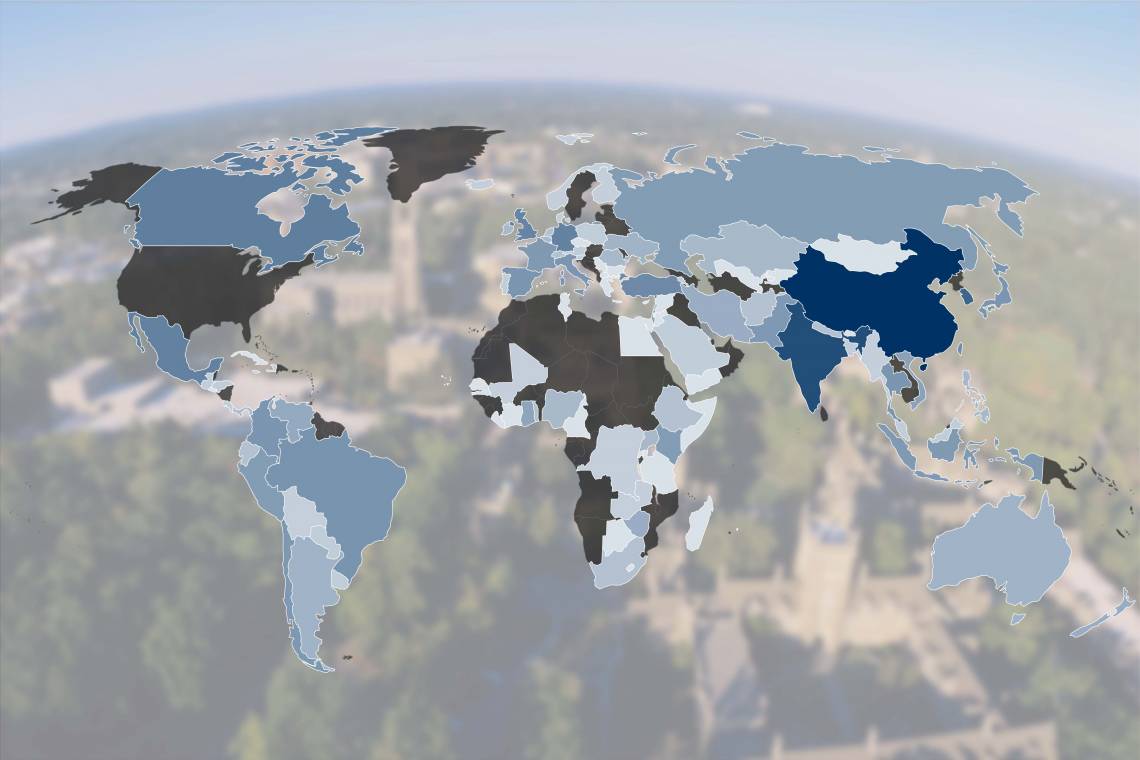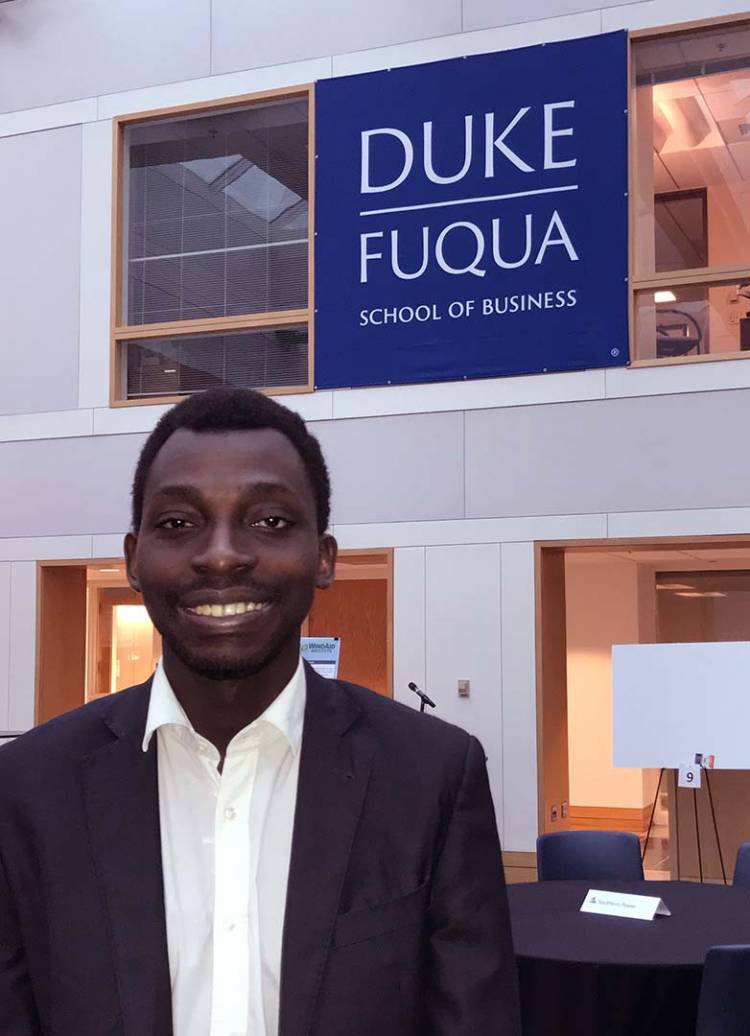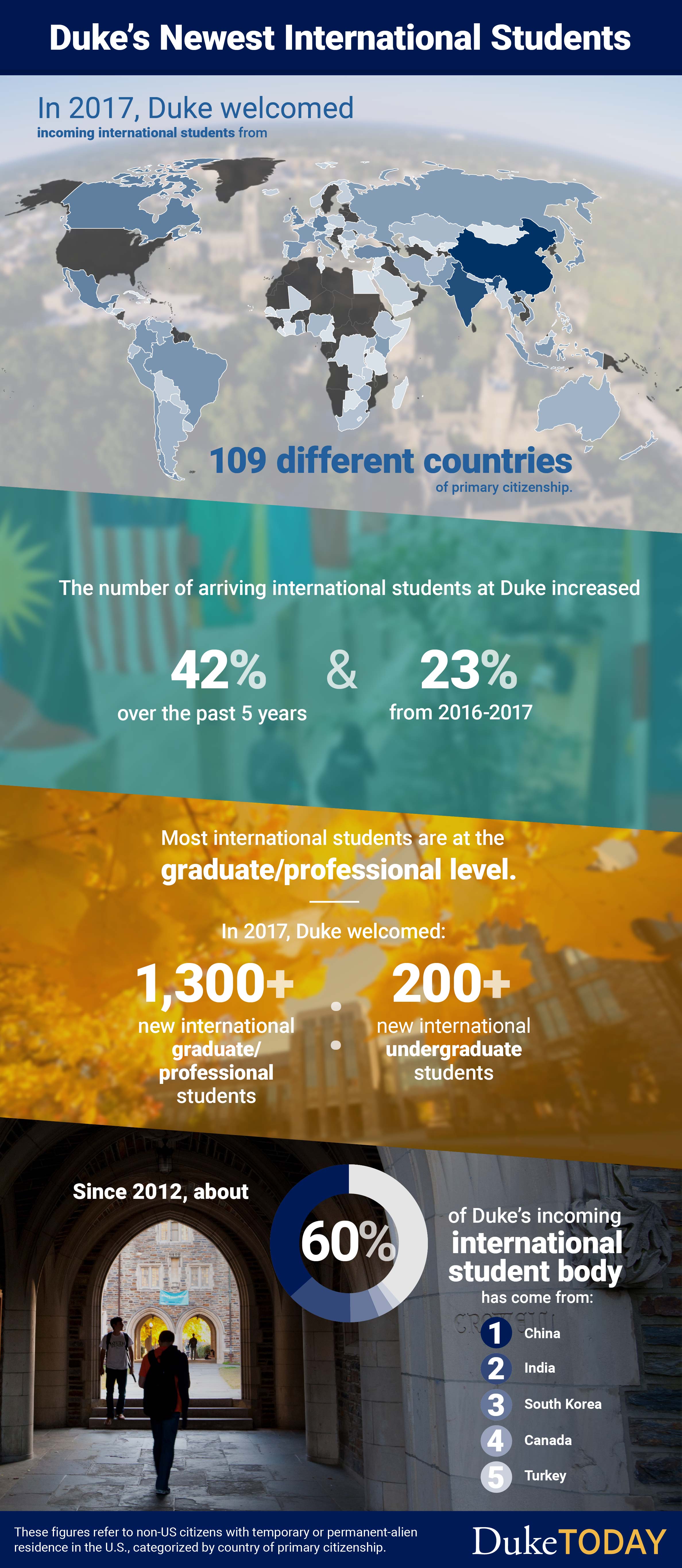
DURHAM, N.C. – In 2017 Duke welcomed more than 1,500 new international students representing 109 countries of primary citizenship. These undergraduate, graduate and professional students are among the largest and most diverse groups the university has ever welcomed in a single year, and include Duke’s first students from Cote D’Ivoire, San Marino, and Saint Vincent and the Grenadines.
According to data released this week by the Institute of International Education (IIE) and the U.S. State Department, U.S. colleges and universities hosted more than one million international students in academic year 2016-2017 (the most recent year for which national data are available). While the overall number of international students in the United States increased in 2016-2017, the number of new international students – those enrolled at a U.S. institution for the first time in fall 2016 – declined by three percent compared with the previous year.
However, the number of new international students enrolling at Duke continues to rise. Duke’s new international student population has increased 42 percent since 2012 and 23 percent since fall 2016.
This year’s increase is partially due to significant growth in the number of entering international students in the Master of Engineering Program at the Pratt School of Engineering, as well as the launch of the Master of Quantitative Management program at the Fuqua School of Business. More than 80 percent of students in the inaugural class are international. Fuqua leadership anticipated the program would have strong demand from applicants, including international students.
Russ Morgan, Fuqua’s senior associate dean for full-time programs, noted that the program’s mix of analytics with business training has strong appeal for domestic and international students, and that the current demand for this type of skill by companies makes attending a U.S.-based program even more appealing for international students who are hoping to work in the U.S. after graduation.

One of those students is Jean Dominique Vidjanagni, who comes from Cote D’Ivoire. After earning his undergraduate degree, Vidjanagni worked for a year at a manufacturing company. “When I was working, I got to interact with a lot of data. I could use Excel, I could pop out a graph, I could do those basic things but I couldn’t really interact at a deeper level with the data. That was very frustrating to me,” said Vidjanagni, who after graduation expects to land a job in investment banking or consulting.
Besides being a member of the Master of Quantitative Management program’s first class, Vigjanagni is also the first student from Cote D’Ivoire to attend Duke.
“Being the first person from Cote D’Ivoire feels pretty amazing. It also makes me feel like I am a pioneer for something that I could turn into something bigger,” he said. “ When I go back home to Cote D’Ivoire, I will try to make my kids go to Duke, or even my friends’ kids. Duke is amazing and the experience has been amazing so far.”
The growing diversity of international students coming to Duke is the result of intentional efforts to attract students from the widest possible variety of backgrounds.
“Our most important goal, other than obviously maintaining a strong and robust cohort, is increasing the diversity in terms of the composition of that international group, while still responding fairly to the strength of applications,” said Anne Sjostrom, associate dean for Undergraduate Admissions, whose team travels to high schools around the world to promote Duke to prospective undergraduate students.
Sjostrom is also quick to point out that citizenship and residency data only tell part of the story of Duke’s international students.
“We have so many students who are citizens of one or more countries, but who reside in yet another country, and in some cases attended high school in yet another country,” Sjostrom said. “The global experiences and mindsets these students are bringing to our campus are a tremendous benefit to the whole Duke community.”
Duke’s support for graduate students
Nationally, the majority of international students coming to U.S. universities are enrolled at the graduate level. And that’s true at Duke as well, where more than 80 percent of this year’s arriving international students are studying in graduate and professional degree programs.
One of those students is Fifaliana Ratodimahavonjy, a Fulbright scholar and Duke Law School’s first student from Madagascar. She is also the recipient of the Judy Horowitz LLM Scholarship, which honors former Associate Dean Judy Horowitz, the architect of Duke Law’s International LLM program who retired in 2013 after leading the program for 33 years.
Fifaliana chose Duke for its rigorous program in law and its global reputation.

“I wanted more international and intercultural experiencies,” she said. She also sought a program that would allow her to broaden her knowledge of international business law, particularly in the area of state-investor dispute relations. “Currently I am taking a lot of amazing classes like International Business Law and International Arbitration. In my country there are a lot of foreign investors coming for mining purposes, and the problem is that there are very few practitioners who specialize in investment and state relations,” she said.
But academic and career opportunities were not the only factors that Ratodimahavonjy considered before committing to Duke.
“Duke has this connection with Madagascar because of the Lemur Center,” she said. “It is a little part of Madagascar in the middle of North Carolina. When I looked at universities I saw that Duke had a good connection with my country and it was also a good international program. I was happy to come here.”
